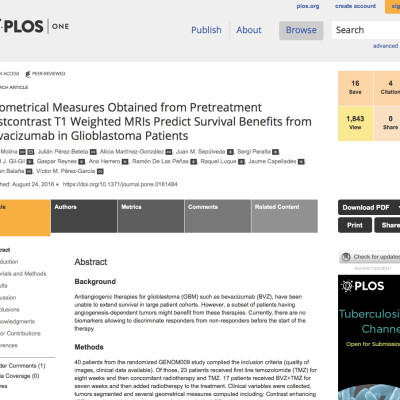Publication
Geometrical measures obtained from pretreatment postcontrast T1 weighted MRIs predict survival benefits from bevacizumab in glioblastoma patients
D. Molina, J. Pérez-Beteta, A. Martínez-González, J.M. Sepúlveda, S. Peralta, M. Gil-Gil, G. Reynes, A. Herrero, R. De Las Peñas, R. Luque, J. Capellades, C. Balaña, V.M. Pérez-Garcia
PLoS One 11(8) e0161484 (2016).
MOLAB authors
Abstract
Background: Antiangiogenic therapies for glioblastoma such as bevacizumab (BVZ), have been unable to extend survival in large patient cohorts. However, a subset of patients having angiogenesis-dependent tumors might benefit from these therapies. Currently, there are no biomarkers allowing to discriminate responders from non-responders before the start of the therapy.
Methods: 40 patients from the randomized GENOM009 study complied the inclusion criteria of our study (quality of images, clinical data available). Of those, 23 patients received first line temozolomide (TMZ) for eight weeks and then concomitant radiotherapy (RT) and TMZ. 17 patients received BVZ+TMZ for seven weeks and then added RT to the treatment. Clinical variables were collected, tumors segmented and several geometrical measures computed including: Contrast enhancing (CE), inner (necrotic), and total volumes; maximal tumor diameter; equivalent spherical CE width, several geometric measures of the CE ‘rim’ geometry and a set of image texture measures. The significance of the results was studied using Kaplan-Meier curves and Cox proportional hazards analysis. Correlations between variables were assessed using Spearman correlation coefficients.
Results: Kaplan-Meier and Cox survival analysis showed that total, CE and inner volume (p=0.019, HR=4.258) and geometric heterogeneity of the CE areas (p=0.011, HR=3.931) features were significant parameters in terms of response to BVZ. Moreover, a small group of patients with regular CE areas (small geometric heterogeneity) benefited substantially from BVZ, with median difference survival of 15.88 (p=0.011).
Conclusion: An imaging biomarker related to the irregularity of contrast enhancing areas was able to discriminate GBM patients with a substantial survival benefit from BVZ. A prospective study is needed to validate the results obtained in this preliminary study.















